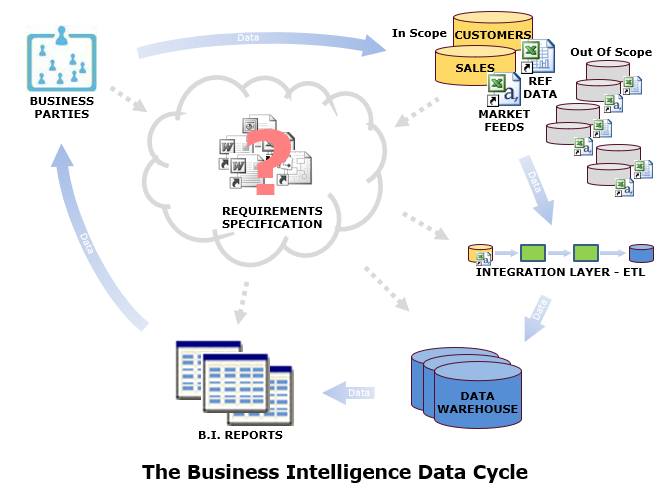Business Intelligence
Organisations spend significant amounts of money and development effort on Business Intelligence (B.I.) applications in order to inform operational & strategic decision making.

However, the value of any B.I. application depends on…
(1) The quality of its data – i.e. the validity & accuracy of data in the source applications, plus the validity of the logic used to extract and integrate that data, and…
(2) The quality of its metadata – i.e. the meaningfulness of physical references, such as captions or column headers, in forms and reports.
The Change Management Model is founded on the visibility, definition & ownership of data across all business activities. Therefore, using it to document a B.I. solution (or any other type of solution) ensures that data & metadata quality is sustained over time, as follows…
In its most basic form a B.I. requirements specification will only contain references to physical data for the in-scope sources, integration layer, data warehouse and B.I. reports. The lack of any logical references to qualify the physical data means that this amounts to Selective Undefined Business Intelligence, where the solution has limited visibility, no definition and no ownership.
If the requirements specification is improved by mapping the physical data to a logical data model (i.e. a set of logical definitions and domain values) covering the same scope, the solution becomes Selective Defined Business Intelligence, having limited visibility, limited definition, yet no ownership.
Next, if the extent of the logical data model and associated physical data mappings is increased to all business systems in the enterprise, the solution becomes Enterprise-Wide Business Intelligence because, although the scope of the B.I. source data hasn’t changed, the application can now be viewed in an enterprise-wide context (rather than a selective context) – i.e. analysts, developers and users can see how the B.I. application data maps to any of the other business systems; so that this represents total visibility and total definition, yet still no ownership.
Finally, if responsibility for the pro-active management of all business activities and data is assigned to nominated business parties, the solution becomes Sustainable Enterprise-Wide Business Intelligence, because the B.I. application will now be included in the process of managing change in business systems. This represents total visibility, total definition and total ownership.
